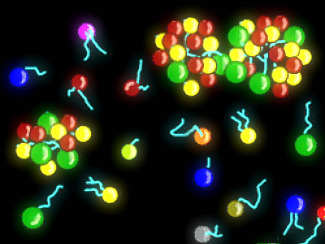What came first in the origin of life?

A research published in “Proceedings of National Academy of Sciences” rejects the theory that the origin of life stems from a system of self-catalytic molecules capable of experiencing Darwinian evolution without the need of RNA or DNA and its replication. The research, which was carried out with the participation of Mauro Santos, researcher of the Department of Genetics and Microbiology at (UAB), has demonstrated that, through the analysis of what some researchers name “compound genomics”, these chemical networks cannot be considered evolutionary units because they lose properties which are essential for evolution when they reach a critical size and greater level of complexity.
The National Aeronautics and Space Administration (NASA) defines life as a “self-sustaining chemical system capable of Darwinian evolution". The scientific theories on the origin of life revolve around two main ideas: one focuses on genetics - with RNA or DNA replication as an essential condition for Darwinian evolution to take place - and the other focuses on metabolism. It is clear that both situations must have begun with simple organic molecules formed by prebiotic processes, as was demonstrated by the Miller-Urey experiment (in which organic molecules were created from inorganic substances). The point in which these two theories differ is that the replication of RNA or DNA molecules is a far too complex process which requires a correct combination of monomers within the polymers to produce a molecular chain resulting from the replication.
Until now no plausible chemical explanation exists for how these processes occurred. In addition, defenders of the second theory argue that the processes needed for evolution to take place depend on primordial metabolism. This metabolism is believed to be a type of chemical network entailing a high degree of mutual catalysis between its components which, in turn, eventually allows for adaptation and evolution without any molecular replication.
In the first half of the 20th century, Alexander Oparin established the “Metabolism First” hypothesis to explain the origin of life, thus strengthening the primary role of cells as small drops of coacervates (evolutionary precursors of the first prokaryote cells). Dr Oparin did not refer to RNA or DNA molecules since at that time it was not clear just how important the role of these molecules was in living organisms. However he did form a solid base for the idea of self-replication as a collective property of molecular compounds.
Science has more recently demonstrated that sets of chemical components store information on their composition which can be duplicated and transmitted to its descendents. This has led to their being named “compound genomes” or composomes. In other words, heredity does not require information in order to be stored in RNA or DNA molecules. These “compound genomes” apparently fulfil the conditions required to be considered evolutionary units, which suggests a pathway from pre-Darwinian dynamics to a minimum protocell.
Researchers in this study nevertheless reveal that these systems are incapable of undergoing a Darwinian evolution. For the first time a rigorous analysis was carried out to study the supposed evolution of these molecular networks using a combination of numerical and analytical simulations and network analysis approximations. Their research demonstrates that the dynamics of molecular compound populations which divide after having reached a critical size do not evolve, since during this process the compounds lose properties which are essential for Darwinian evolution.
The scientists concluded that this fundamental limitation of “compound genomes” should lead to caution towards the theories that set metabolism first as the origin as life, even though former metabolic systems could have offered a stable habitat in which primitive polymers such as RNA could have evolved.
Researchers state that different prebiotic Earth scenarios can be considered. However, the basic property of life as a system capable of undergoing Darwinian evolution began when genetic information was finally stored and transmitted such as what occurs in nucleotide polymers (RNA and DNA).
Full articleReferences
"Lack of evolvability in self-sustaining autocatalytic networks constraints metabolism-first scenarios for the origin of life". Vasas, V., E. Szathmáry, M. Santos. Proceedings of the National Academy of Sciences of the USA PNAS. Published online before print January 4, 2010.

